Houseplant Care
Success with houseplants is governed by one’s careful management of light, temperature, water, nutrients, and humidity, along with using the proper potting medium.
Light
Very few plants tolerate dark corners. Most houseplants require the light that would be found within four to eight feet of a bright south window. Some will tolerate a spot very near the window, while others will prefer less light some distance away. Too little light can result in tall, lanky, small-leafed plants. Too much light can cause leafburn on sensitive species like African Violet. Drapes should be left open during the day where houseplants are being grown; however, be careful not to allow the plants’ leaves to touch the glass of the window.
If the room is not naturally lit, artificial lights should be used. A 100-watt table lamp can be used about three feet above plants. Specially built fluorescent plant lights or plant flood lamps are available. Either fluorescent or incandescent plant lights are satisfactory for growing plants. (See OSU Extension Fact Sheet HLA-6401, “Growing Under Lights” for more information.)
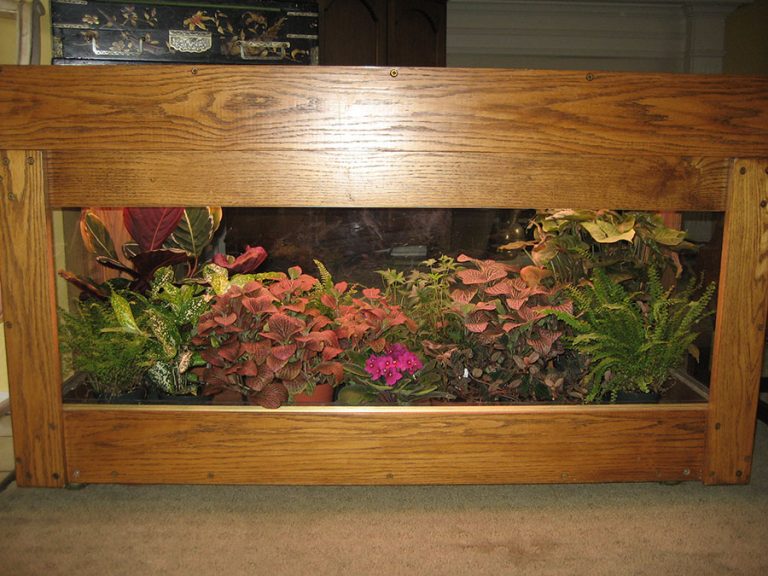
Figure 1. Grow houseplants in a Wardian case or under fluorescent plant lights if natural light is limited.
Temperature
Avoid placing plants in hot spots or cold drafts. Almost none will survive the hot, dry air from a furnace vent, nor like being placed near a door where cold drafts enter.
Most houseplants prosper in a temperature of 65°F to 75°F, but the humidity of the average home is too low to suit them. A plant prospers in relative humidity of about 50 to 60 percent, which is more than most people like.
This can be helped by using a humidifier or by setting the pot on a tray of moist gravel or pebbles. Do not allow the water to touch the bottom of the pot, as the water would then be wicked into the potting medium and keep the plant too wet. A transparent polyethylene bag can be draped over the top of plants that are extremely humidity sensitive or are in poor condition.
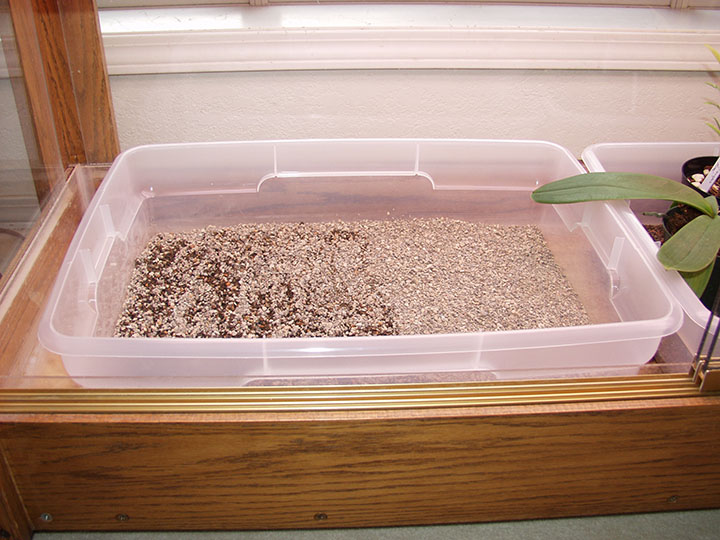
Figure 2. Increase humidity around houseplants by placing them on a tray of moist gravel or pebbles.
Watering
More houseplants succumb from improper watering than from any other single cause.
In general, most houseplants need to be thoroughly watered and then allowed to nearly
dry before the next irrigation. Use tepid water when watering houseplants. Enough
water needs to be poured over the potting medium to allow water to drain freely through
the drain hole at every watering. If water does not drain out the bottom, rewater
until it drains freely. Never leave a houseplant standing in water, as this will cause
the roots to rot.
Generally, plants are watered when the potting medium becomes dry to the touch. However, some plants such as African violet and Rex begonia, need to be watered before the potting medium becomes completely dry to the touch. (Refer to OSU Extension Fact Sheet HLA-6413 for poinsettia care in the home.) Cacti and other succulents need to be allowed to remain dry a few days before watering, even though the top of the potting medium may be dry to the touch.
Watering frequency depends on the potting medium used, season, amount of light, temperature, humidity, plant species, and pot size. Small pots are more difficult to manage in the home than larger pots, since they dry more rapidly, and water does not move as uniformly through the potting medium. Small pots may require watering every two to three days, while large pots may not need watering more than every seven to fourteen days.
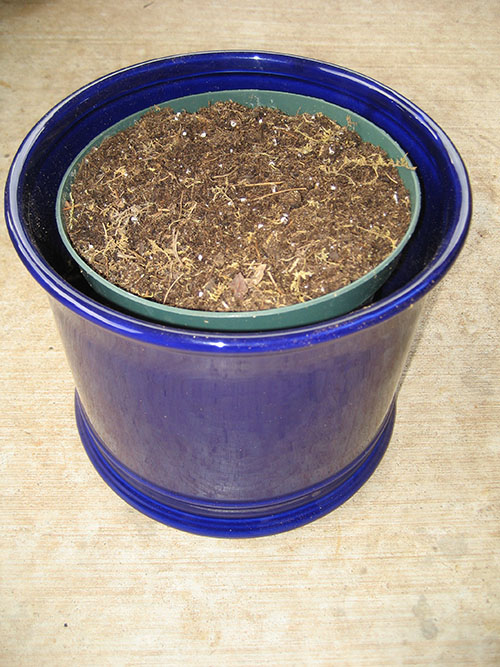
Figure 3. Use a “pot within a pot” technique to avoid overwatering pots without drain holes.
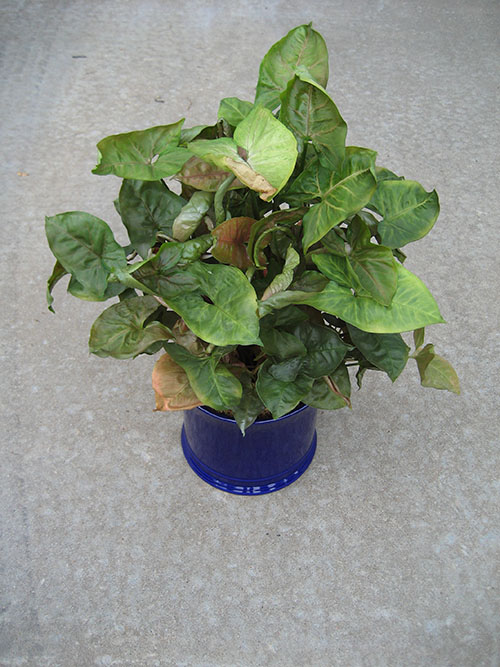
Drainage
Drainage is an integral part of watering a plant. A pot’s drain hole can be covered with a small piece of broken pot or similar item to keep potting medium from sifting through the hole. Do not include other aggregates in the bottom, since the aggregate actually slows water’s movement through a pot. Research has shown that for optimal growth of the plant, pots should be filled only with the proper potting medium.
If there is no hole in the bottom of the container, then the amount and frequency of watering is much more critical. Drainless pots normally require watering half as often and with much less water since excess water cannot get out of the pot. Overwatering is very critical in the drainless pot. It is far better to underwater than to overwater. Pour water in the top of the drainless pot until it comes to no more than 1/3 to 1/2 of the distance from the surface of the potting medium to the brim of the pot. Let this percolate before adding any more water. If it percolates slowly, use no more water. Overwatering is the chief cause of troubles of houseplants growing in drainless pots. In case of overwatering, turn the pot on its side and allow the excess water to drain out the top of the pot.
If a decorative, drainless pot is desired, it would be better to use a “pot within a pot” technique: pot the plant in a container with drain holes and then set that into the larger, decorative pot. Styrofoam packing “peanuts” can be used to adjust the height of the inner pot within the decorative pot, and long-fiber Sphagnum moss or sheet moss can be used to finish the surface decoratively. Never allow excess water to collect in the outer pot.
Many plants in hanging baskets have been lost by not watering enough. Hanging plants tend to dry more quickly since warm air rises and, therefore it is warmer where the pot is hanging. Water thoroughly at every watering, allowing the excess water to drain into a sink or basin. The hanging plant is a sensible place to use the drainless pot; however, growing plants in pots without drain holes can be challenging.
Potting Medium
Potting media high in peat moss dry more slowly than those high in vermiculite or perlite. Regardless of pot size, plants growing in potting mixes high in perlite or vermiculite will require greater frequency of watering and fertilizing than those growing in mixes with soil.
Consult your local garden center, greenhouse, or florist for help selecting an appropriate potting medium. It is important that the potting medium has good water holding capacity, yet is loose enough to promote good drainage and aeration. In general, a potting medium composed of approximately 50 percent peat moss, 35 percent bark, and 15 percent perlite will suit the substrate needs of most houseplants.
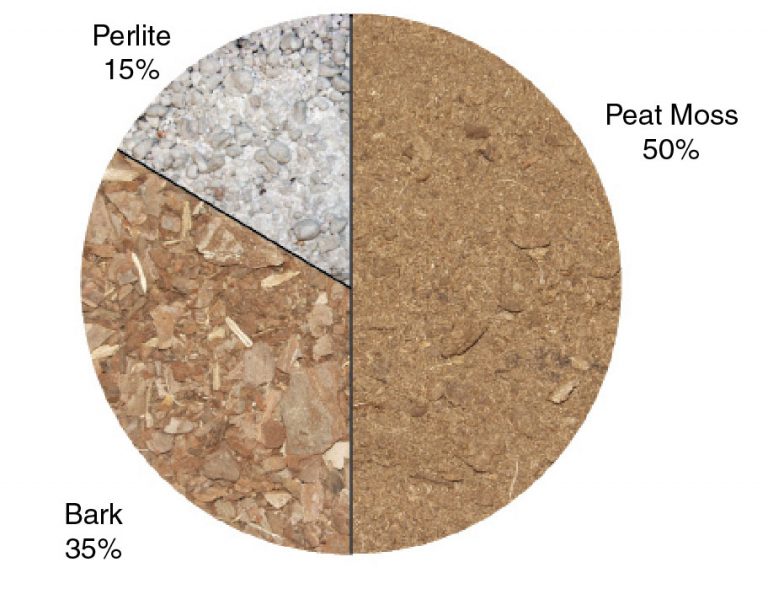
Figure 4. For most houseplants, select a potting medium that is approximately 50 percent peat moss, 35 percent bark, and 15 percent perlite.
Fertilizers
The easiest way to fertilize your houseplants is while watering. Select a houseplant fertilizer and dilute according to label directions. Houseplants can be fertilized at every watering with a very dilute rate, or fertilized at a slightly higher rate once every third or fourth watering. Fertilizer frequency varies with season, amount of light, temperature, plant species, and potting medium. Do not fertilize as often or as much in the winter, in dimly-lit rooms, or in potting mixes that contain soil. If fertilizer accidentally gets on foliage, rinse promptly.
Fertilizer brand is not important, but the degree of solubility is. Houseplant fertilizer should be completely soluble in water. Specialty fertilizers may be purchased at most garden centers, greenhouses, and florists.
Shop wisely, and compare actual ingredients and volume of fertilizer to total price.
Many highly advertised fertilizers have no more fertility than less costly ones. However,
certain conveniences in using the fertilizer should be considered as part of the price.
Slow-release tablet or pellet-type fertilizers can also be used. A small amount of
fertilizer dissolves with every watering. Follow label directions for the amount to
use for a given pot size. Slow-release fertilizers are effective and convenient.
Regardless of the type of fertilizer used, always remember to water thoroughly. Water volume should not vary, as the volume of water used is necessary to keep excess fertilizer salts leached out of the potting medium. A plastic or ceramic pot with a drain hole is superior to a clay pot since these salts cannot accumulate in a non-porous container. The white residue around the outside of old clay pots is fertilizer salt. Plant roots near the accumulated fertilizer salt will likely be burned as will leaves or leaf petioles resting on the fertilizer salt residue at the edge of the pot.
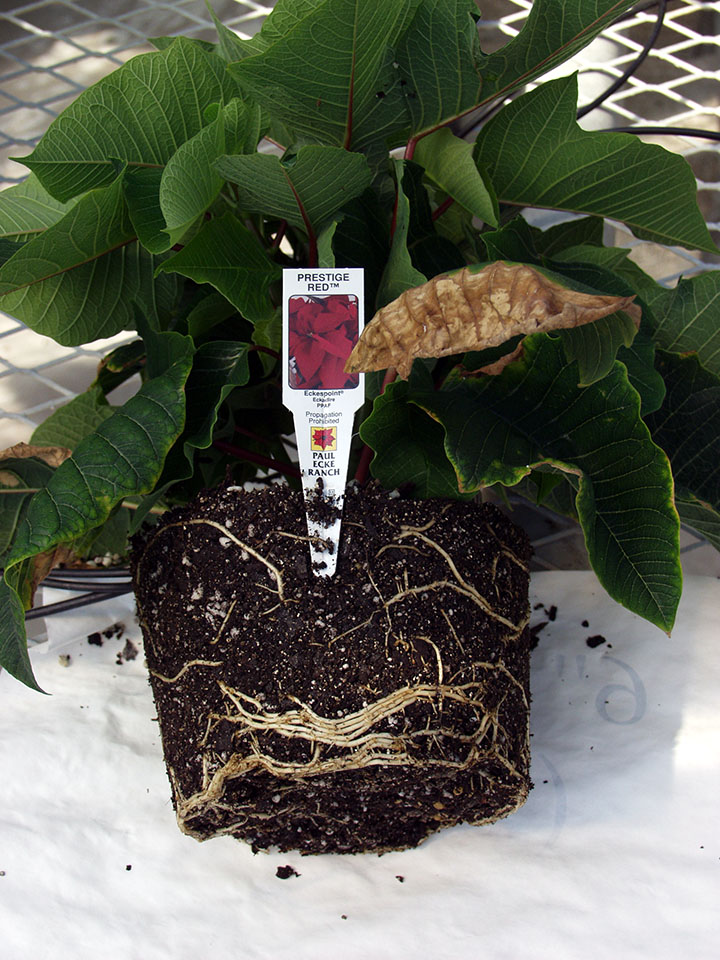
Figure 5. A healthy root system should be white and vigorous. Check the roots every 6 to 12 months.
Problem-Solving
Most problems result from too little or too much water. Only by careful observation can one determine what is wrong with a certain plant. When leaves turn yellow and start dropping off, it is usually caused by too much water, too low humidity, poor drainage, tight soil mixes, or temperature shock from getting too cold or too warm.
Yellow, dropping leaves usually occur when a plant is brought from the moist, warm, brightly-lit conditions of a greenhouse into the home where it must adjust to the new environment. Watering the plant properly and draping transparent polyethylene bags over it will lessen the shock. The plant should adapt to its new surroundings within a few days.
Wilting may be caused by a lack of water or too much water. Too much water in the pot or a pot sitting in water can cause wilting. If the potting medium is moist but the plant is wilted, inspect the roots. It is likely that they have rotted.
Browning of leaf margins is usually caused by too little water, too much fertilizer, windburn, or sunburn. If marginal leafburn is a result of fertilizing, leach the plant by running extra water through the potting medium to wash the excess fertilizer out. Then let the potting medium dry before watering again.
Pale foliage and stunted growth can indicate too little fertilizer or that the plant has been in the pot too long and is rootbound. To check for pot-boundness, invert the pot with the plant stem between the fingers. Then gently tap the pot top against a solid object. The root mass should slip into your hand for examination.
Roots should be white and vigorous. If they are crowded and brownish, the plant is pot bound and should be repotted. Check for this condition about every 6 to 12 months. If repotting is indicated, select a pot that is only 1 to 2 inches larger in diameter than the pot in which the plant is currently growing.
Diseases and Pests
Diseases other than root rots from overwatering seldom bother plants in the home.
An occasional “shower” will benefit most plants. The pleasing natural gloss of leaves is enhanced more by cleaning with water or with a weak solution of a mild soap than with leaf shining products; however, be sure to remove any soap residue with clear water. Small plants can be showered with water from the spray head at the kitchen sink, and larger plants can be showered with water in the bathtub or shower. The water spray should not be too hard, and it should be tepid in temperature. This will remove dust, dirt, and many insects and pests that might affect the plant. Always inspect plants for pests as you water and care for them.
If insects or pests are a problem, submerging the plants in a tub of water for about 30 minutes may cause the insects to rise to the surface of the water where they can be skimmed off. Enclose the pot in a plastic bag to keep the potting medium in place during this treatment.
Aphids (plant lice) and mealybugs (cottony) are common insect problems of houseplants. Insecticides properly diluted and applied will eliminate most infestations. Then, usually by early isolation and retreatment, the insect infestation can be controlled with minimum insecticide treatments.
Spider mites can also damage houseplants. These are red, black, brown, or tan pests that are about the size of a dust particle. They usually feed from the undersides of the leaves causing the top side to turn pale. They are a greater problem during periods of high temperature and low humidity. Showering your houseplants once or twice a month will help control these tiny pests.
Where only a few plants are involved, an alcohol-soaked cotton swab can be used to
wipe off any aphids, mealybugs, and scale insects. Before treating houseplants with
an insecticide, regardless of chemical, put them where there is plenty of ventilation.
Allow them to dry thoroughly before bringing them back into the room. Always follow
label directions.
Systemic insecticides formulated for homeowner use can be sprinkled in the pots with growing plants to control most insect problems. Consult your local garden center, greenhouse, or local OSU Extension Office for the latest pest control recommendations.
Do not apply pesticides without a proper reason. Read and heed all label warning and directions. Do not treat houseplants with pesticides if people with respiratory problems live in the home. Be sure to keep all pesticides and plants that have been treated with pesticides out of the reach of children and pets.
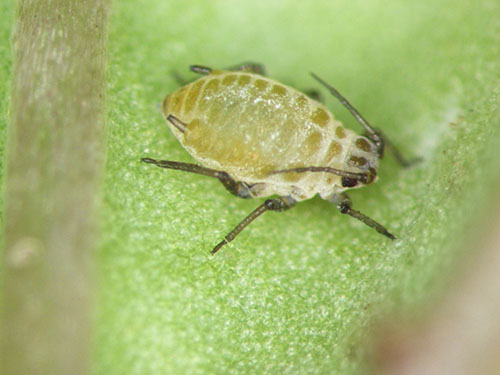
Figure 6. Aphid (top) and mealybugs (bottom) are common insect problems. (Photos highly magnified.)
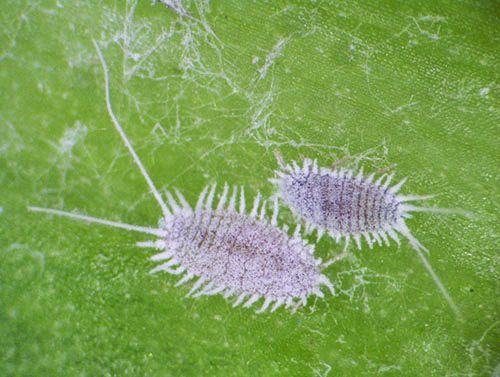
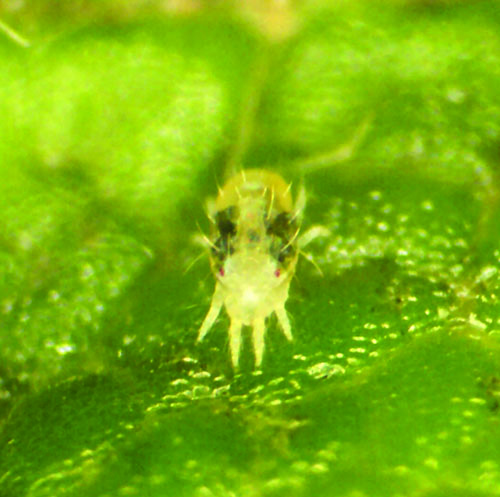
Figure 7. Spider mites (top, photo highly magnified) are very tiny, but can kill houseplants. Scale insects (bottom) suck plant fluids, leaving a sticky residue on nearby surfaces.
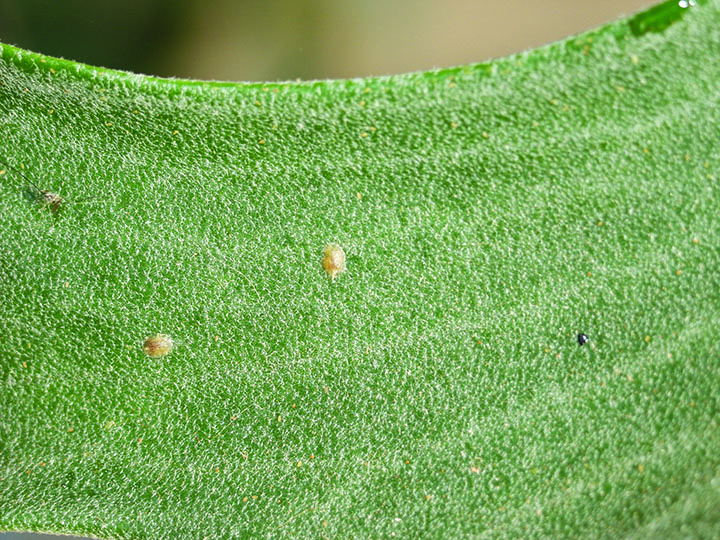
Houseplant Selection
Houseplants can change the look of one’s home or office from the common to the exotic. Consult the following list of houseplants to suit your indoor growing environment. The list is not intended to be exhaustive. Visit your local garden center, greenhouse, or florist for additional plant species and cultivars.
Low to Medium Light
(150-500 footcandles)
Aluminum Plant (Pilea cadierei)
Anthurium (Anthurium × ferrierense cvs.)
Aralia, False (Schefflera elegantissima)
Arrowhead Vine (Syngonium podophyllum)
Artillery Plant (Pilea microphylla)
Begonia, Rex (Begonia Rex Cultorum Hybrids)
Bromeliad (Genera of the Bromeliaceae)
Cactus, Thanksgiving (Schlumbergera truncata); Christmas (S. × buckleyi); and Easter (Hatiora gaertneri and H. × graeseri)
Cast-Iron Plant (Aspidistra elatior)
Chinese Evergreen, Variegated (Aglaonema commutatum)
Creeping Charley (Pilea nummulariifolia)
Fern, Boston (Nephrolepis exaltata ‘Bostoniensis’)
Fig, Creeping (Ficus pumila)
Friendship Plant (Pilea involucrata)
Geranium or Begonia, Strawberry (Saxifraga stolonifera)
Gloxinia, Florists’ (Sinningia speciosa)
Ivy, Grape (Cissus rhombifolia)
Ivy, Swedish (Plectranthus verticillatus)
Lily, Peace (Spathiphyllum ‘Viscount’ or ‘Petite’)
Nerve Plant (Fittonia verschaffeltii)
Orchid (Paphiopedilum and Phalaenopsis spp. and cvs.)
Palm, Parlor (Chamaedorea elegans)
Peperomia (Peperomia spp. and cvs.)
Philodendron, Heart-Leaf (Philodendron scandens oxycardium)
Pickaback Plant or Piggyback Plant (Tolmiea menziesii)
Pothos, Golden (Epipremnum aureum)
Prayer Plant, Rabbit’s-Tracks (Maranta leuconeura var. Kerchoviana)
Snake Plant or Mother-in-Law’s Tongue (Sansevieria trifasciata cvs.)
Violet, African (Saintpaulia ionantha)
Violet, Flame (Episcia cupreata)
Wandering Jew (Tradescantia zebrina)
Medium to High Light
(500-1000 footcandles)
Amaryllis (Hippeastrum cvs.)
Azalea, Florist’s (Rhododendron cvs.)
Cactus (Genera of the Cactaceae)
Camellia (Camellia japonica)
Cineraria, Florist’s (Pericallis × hybrida)
Corn Plant, Striped (Dracaena fragrans ‘Massangeana’)
Croton (Codiaeum variegatum var. pictum)
Cyclamen, Florist’s (Cyclamen persicum)
Dumbcane (Dieffenbachia maculata)
Fig, Benjamin (Ficus benjamina)
Gardenia, Common (Gardenia augusta cvs.)
Geranium, Regal or Lady Washington (Pelargonium × domesticum)
Hawaiian Ti Plant (Cordyline terminalis)
Hydrangea, Florists’ (Hydrangea macrophylla)
Ivy, English (Hedera helix)
Jade Plant (Crassula ovata)
Kalanchoe (Kalanchoe blossfeldiana cvs.)
Lily, Easter (Lilium longiflorum cvs.)
Mum, Florist’s (Chrysanthemum × morifolium cvs.)
Norfolk Island Pine (Araucaria heterophylla)
Orchid (Cattleya, Cymbidium, and Dendrobium spp. and cvs.)
Pocketbook Plant (Calceolaria herbeohybrida)
Poinsettia (Euphorbia pulcherrima cvs.)
Primrose (Primula Pruhonicensis Hybrids)
Purple Velvet or Purple Passion Plant (Gynura aurantiaca ‘Purple Passion’)
Rubber Plant (Ficus elastica cvs.)
Schefflera, Dwarf or Hawaiian (Schefflera arboricola)
Shrimp Plant (Justicia brandegeana)
Spider Plant, Variegated (Chlorophytum comosum ‘Vittatum’)
Violet, Persian (Exacum affine)
Wax Plant (Hoya carnosa)
Zebra Plant (Aphelandra squarrosa)
David Hillock
Assistant Extension Specialist, Consumer Horticulture
